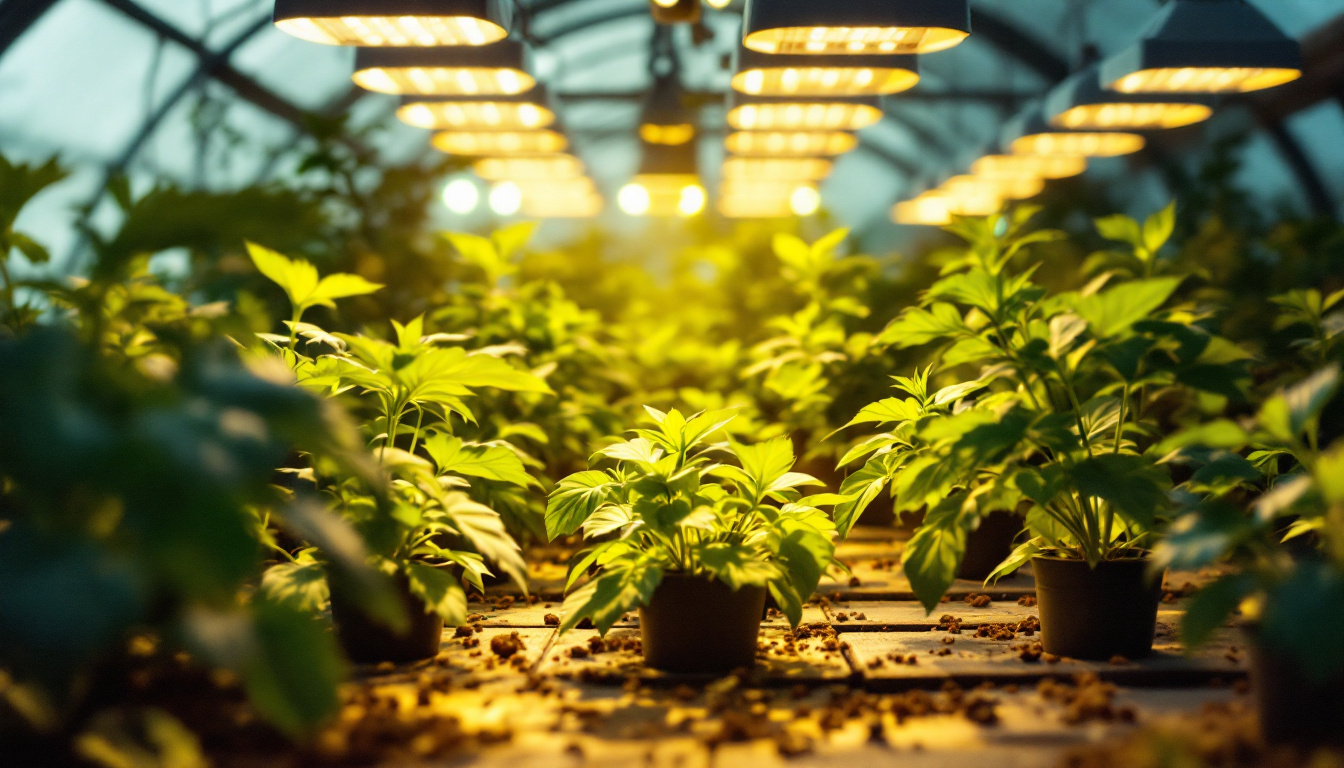
In the evolving world of horticulture, the role of lighting has taken center stage, especially in greenhouse operations. Grow lights are no longer just an accessory; they are essential tools that can significantly enhance plant growth and yield. For lighting contractors, understanding the intricacies of grow lights and their applications in greenhouses is crucial. This article delves into the importance of grow lights, the types available, and why every lighting contractor should prioritize this aspect of their service.
Greenhouses are designed to create an optimal environment for plant growth, but they often fall short in providing adequate natural light. This is where grow lights come into play. They not only supplement natural sunlight but also provide the specific wavelengths of light that plants need for photosynthesis.
Proper lighting can lead to faster growth rates, improved plant health, and higher yields. For contractors, being well-versed in the benefits of grow lights can enhance their service offerings and help clients achieve their horticultural goals.
Plants rely on light for photosynthesis, the process through which they convert light energy into chemical energy. Grow lights can be tailored to emit specific wavelengths that promote various stages of plant growth. For instance, blue light is essential for vegetative growth, while red light encourages flowering and fruiting.
By understanding these nuances, lighting contractors can recommend the most suitable grow light systems to their clients, ensuring that plants receive the optimal light spectrum for their specific needs. This knowledge not only improves client satisfaction but also positions contractors as experts in the field.
Moreover, the use of grow lights can also mitigate the effects of seasonal changes, allowing for consistent growth patterns regardless of external weather conditions. This adaptability is particularly beneficial for growers who wish to cultivate delicate or high-demand crops that require specific light conditions to thrive. As a result, the integration of grow lights can lead to a more diverse range of plants being cultivated, ultimately enriching the market offerings available to consumers.
One of the most significant advantages of using grow lights is the ability to extend the growing season. In regions with limited sunlight during certain months, grow lights can provide the necessary illumination for year-round cultivation. This capability allows greenhouse operators to maximize their production and profitability.
Lighting contractors can play a pivotal role in helping clients design lighting schedules that mimic natural sunlight patterns, ensuring that plants receive the right amount of light at the right times. This expertise can be a game-changer for clients looking to optimize their greenhouse operations.
Additionally, the ability to extend the growing season can lead to increased crop rotation and diversification. Growers can experiment with different plant varieties that may not typically thrive in their local climate, thus expanding their product range and appealing to a broader customer base. This not only enhances the economic viability of the greenhouse but also contributes to sustainable agricultural practices by reducing the reliance on out-of-season imports. Through strategic planning and the effective use of grow lights, contractors can empower their clients to achieve remarkable results in their greenhouse endeavors.
Understanding the different types of grow lights available is essential for lighting contractors. Each type has its own advantages and applications, and the choice largely depends on the specific needs of the plants being grown.
LED grow lights have gained immense popularity due to their energy efficiency and longevity. They emit very little heat, reducing the risk of overheating plants while providing a full spectrum of light. Furthermore, LEDs can be customized to emit specific wavelengths, allowing for targeted growth enhancement.
For contractors, recommending LED systems can lead to significant energy savings for clients, making them an attractive option for both small-scale and commercial greenhouse operations. Additionally, the long lifespan of LEDs means less frequent replacements, which can be a selling point for clients concerned about maintenance costs.
Fluorescent lights are another common choice for greenhouse applications. They are particularly effective for seedlings and young plants, providing a gentle light that promotes healthy growth without the risk of burning delicate foliage. These lights are also available in various sizes and configurations, making them versatile for different setups.
While not as energy-efficient as LEDs, fluorescent lights are still a cost-effective option for many growers. Lighting contractors should be familiar with the different types of fluorescent grow lights, such as T5 and T8, to provide clients with the best recommendations based on their specific needs.
HID lights, including Metal Halide (MH) and High-Pressure Sodium (HPS) lamps, have been traditional choices for greenhouse lighting. They are known for their high output and ability to cover large areas. MH lights are excellent for vegetative growth, while HPS lights are favored during the flowering stage due to their red spectrum.
However, HID lights generate significant heat and require additional cooling systems to maintain optimal temperatures in the greenhouse. Lighting contractors should weigh the benefits and drawbacks of HID systems when advising clients, ensuring that they choose a lighting solution that aligns with their operational goals and environmental conditions.
When selecting a grow light system, several factors must be considered. Lighting contractors need to assess the specific requirements of the plants being grown, the size of the greenhouse, and the budget available for lighting solutions.
Different plants have varying light requirements. For instance, leafy greens may thrive under lower light levels, while fruiting plants often require more intense light. Understanding these needs allows contractors to recommend the right type and intensity of grow lights, ensuring optimal growth conditions.
Additionally, factors such as the growth stage of the plants—seedling, vegetative, or flowering—should influence the choice of lighting. Contractors should work closely with clients to evaluate their specific crop requirements and tailor lighting solutions accordingly.
The size and layout of the greenhouse play a significant role in determining the appropriate lighting system. Larger greenhouses may require multiple light fixtures to ensure even coverage, while smaller setups might benefit from fewer, more powerful lights.
Contractors should also consider the positioning of the lights to minimize shadows and ensure that all plants receive adequate light. This may involve using adjustable fixtures or designing a layout that optimizes light distribution throughout the greenhouse.
Proper installation and maintenance of grow light systems are critical for maximizing their effectiveness and longevity. Lighting contractors must be equipped with the knowledge and skills to ensure that systems are set up correctly and maintained over time.
When installing grow lights, it is essential to follow manufacturer guidelines and best practices to ensure safety and efficiency. This includes proper wiring, securing fixtures, and ensuring that lights are positioned at the correct height above plants.
Contractors should also educate clients on the importance of using timers and light controllers to automate lighting schedules. This not only saves energy but also mimics natural light patterns, promoting healthier plant growth.
Regular maintenance is vital to keep grow light systems functioning optimally. This includes cleaning fixtures, checking for burnt-out bulbs, and ensuring that electrical connections are secure. Contractors should schedule routine inspections to address any issues before they impact plant growth.
As technology continues to evolve, lighting systems may also require upgrades to incorporate newer, more efficient technologies. Contractors should stay informed about advancements in grow light technology and be prepared to recommend upgrades to clients when appropriate.
Investing in grow lights can have a significant economic impact on greenhouse operations. By enhancing plant growth and extending growing seasons, growers can increase their overall yield and profitability.
While the initial investment in grow lights may seem substantial, the long-term savings on energy costs and increased production can offset these expenses. energy-efficient systems, such as LEDs, can drastically reduce electricity bills, making them a financially sound choice for growers.
Moreover, the ability to grow crops year-round can lead to a more stable income stream, allowing greenhouse operators to capitalize on market demands regardless of seasonal fluctuations.
Calculating the return on investment for grow lights involves considering both the direct and indirect benefits. Increased yields, improved plant quality, and reduced energy costs all contribute to a favorable ROI. Lighting contractors should help clients understand these benefits and how to measure their investment’s success over time.
By presenting a clear picture of potential ROI, contractors can build trust with clients and position themselves as valuable partners in their greenhouse operations.
The field of grow lighting is continuously evolving, with new technologies and trends emerging regularly. Staying abreast of these developments is crucial for lighting contractors looking to provide the best solutions for their clients.
smart lighting technology is gaining traction in the greenhouse industry. These systems allow for remote monitoring and control of lighting conditions, enabling growers to adjust settings based on real-time data. This level of automation can lead to more precise control over plant growth conditions, ultimately improving yields.
Contractors should familiarize themselves with smart lighting solutions and be prepared to offer these advanced options to clients seeking to enhance their greenhouse operations.
As sustainability becomes a focal point in agriculture, the demand for eco-friendly lighting solutions is on the rise. Lighting contractors should explore options that minimize environmental impact, such as solar-powered grow lights or systems designed to reduce energy consumption.
By promoting sustainable practices, contractors can attract environmentally conscious clients and contribute to a more sustainable future for the horticultural industry.
In summary, grow lights are an indispensable component of modern greenhouse operations. For lighting contractors, understanding the various types of grow lights, their applications, and the economic benefits they offer is essential for providing top-notch service to clients.
By staying informed about industry trends and advancements, contractors can position themselves as experts in grow lighting, ultimately enhancing their business and helping clients achieve their horticultural goals. Embracing the importance of grow lights is not just an opportunity—it’s a necessity in the ever-evolving landscape of greenhouse horticulture.
Ready to elevate your greenhouse lighting solutions? LumenWholesale is here to support your every need with our extensive range of high-quality, spec-grade lighting products. Our commitment to affordability and quality means you can access the best grow lights on the market at wholesale prices, without the burden of inflated markups. Plus, with free shipping on bulk orders, you can stock up on all your lighting essentials while keeping costs low. Don’t let hidden fees or subpar products hinder your horticultural projects. Discover the best value in wholesale lighting and watch your business—and your clients’ greenhouses—thrive with LumenWholesale.

Discover top outdoor building lighting fixtures and expert tips from lighting contractors.

Illuminate your projects with precision using expert insights on 6-inch recessed can lights.

Discover why lighting contractors should prioritize electrical wall sockets in their projects.

Discover the secrets of expert lighting contractors as they unravel the mysteries of the electrician’s wire snake.